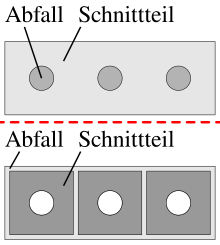Punching tool construction
Die making is a specialty of tool making and manufactures tools (cutting and forming tools) for mass production . It is characteristic of the function of a punching tool that a semi-finished product is brought into a new (desired) shape by the cold forming process ( bending , punching , upsetting , drawing ). For example, a thin sheet metal is formed into a mudguard, a middle sheet metal into a cabinet door hinge and a thick sheet metal into a truck side member. In contrast, drop forging is a hot forming process.
Mass-produced items are used in, for example, the automotive industry or household goods, etc. With the help of tools, a cost-effective and fast production of parts is guaranteed from a certain minimum quantity. Tool making is mainly concerned with the production of three-dimensional drawn and molded parts, but also two-dimensional cut parts (e.g. washers ). The active elements consist of hardened , tempered tool steel , hard metal or ceramic , depending on the area of application . To increase the service life, the active elements are often coated (e.g. TiN , TiCN or AlCrN).
Procedure
The punching and forming tool construction is used to manufacture tools that are required for the serial production of products made of various materials such as metal, non-ferrous metal, plastic, paper, wood veneer, etc.
This type of material processing is always chipless production . According to DIN 8580, the main groups 2 forming and main group 3 cutting .
- Forming tools are used to process all plastically machinable materials
- Punching tools are listed under DIN 8588 (cutting group 3.1). All separable materials are processed.
Forming tools
Forming tools lead to permanent deformation of the material to be processed:
- Pressure forming DIN 8583 (group 2.1)
- Tensile compression forming DIN 8584 (group 2.2)
- Tensile forming DIN 8585 (group 2.3)
- Bending forming DIN 8586 (group 2.4)
- Shear forming DIN 8587 (group 2.5)
- Overall cutting
- Fineblanking
Tool technologies
Depending on the type of construction, the following tool technologies can be distinguished:
Overall cut
The cutting of several cutting lines on the same workpiece in one stroke is called total cutting or complete cutting . Parts are produced that have an internal and external shape. The positional accuracy of the inner to the outer shape is better than with subsequent cutting.
Follow-up cut
As a consequence of cutting the one designated cutting multiple cut lines on the same workpiece in a plurality of strokes . Parts are produced that have an internal and external shape. The positional accuracy of the inner to the outer shape is worse than with overall cutting.
Follow-up
In the progressive tool, the sheet metal strip is clocked through the tool by the respective feed length until the last station is reached. The workpiece is then either separated from the so-called carrier strip (individualized) or wound up as an endless belt for the next work step. In addition to the subsequent cut, forming operations are also carried out in the subsequent group. Other processes such as thread forming or joining can also be integrated into the tool.
Module technology
The modular technology represents a special construction of progressive tools. Here a universally usable basic tool, also called mother frame, is used, which becomes an individual punching tool by means of insertable tool modules. The tool modules mainly consist of hardened module plates. The advantages of this modular design are fast set-up times, easy handling and maximum precision.
Transfer and large tools
In the transfer tool, individual pieces of sheet metal are first cut off in the cutting station. The separated individual parts are then transported from work step to work step by means of grippers and a transfer device coupled to the press. The individual work steps can be seen as individual parts in the tool. This design is often used in the automotive sector with sizes of up to 2 × 5 meters.
Combinations
Combinations of progressive and transfer tools are also possible. The part is first processed as a progressive composite part, separated and then transported to further steps by means of grippers.
Punching frames
The punching frames can be constructed differently depending on the tool technology. Suppliers of standard parts provide standardized and prefabricated punching frames in various sizes and configurations.
Four-pillar frames
The four-pillar frame is mainly used for progressive tools. It is essentially composed of frame plates and functional plates. The frame plates include upper and lower clamping plates or strips, head plate, intermediate plate and base plate. These can be made of tool steel, heat-treated steel or aluminum. The functional plates contain a pressure plate, a punch holder plate in which the cutting punch is suspended, a guide or stripping plate and a cutting plate, also known as a die, which depicts the negative of the cutting punch. These plates are usually made of hardened steel . The guide pillar can either be fastened in the top or base plate. With increased precision requirements, the guide pillar can also be mounted in the middle of the intermediate plate. With this type of column, significantly lower column deflections are achieved under shear forces.
Two-pillar frames
As the name suggests, this frame consists of two columns that can be arranged differently (rear, central or diagonal). They are used in simple insertion operations and small quantities as well as in the modular design as a mother frame.
Cast racks
Cast frames are mainly used for large transfer tools. For the individual processing stations, plates made of hardened steel are usually chosen.




